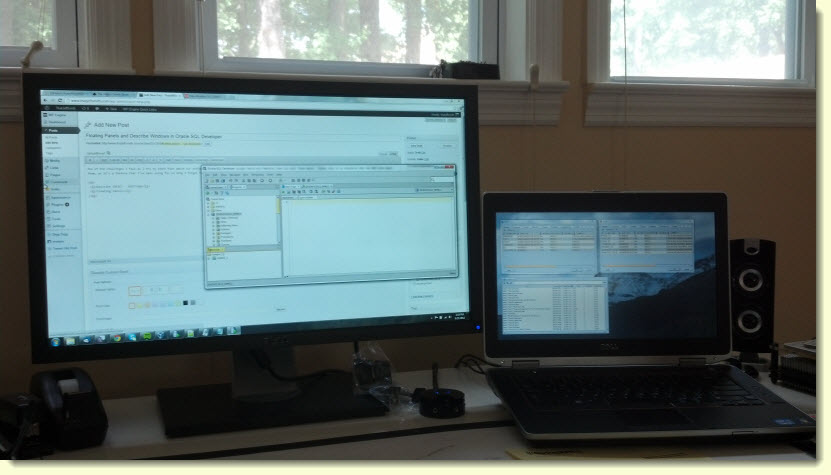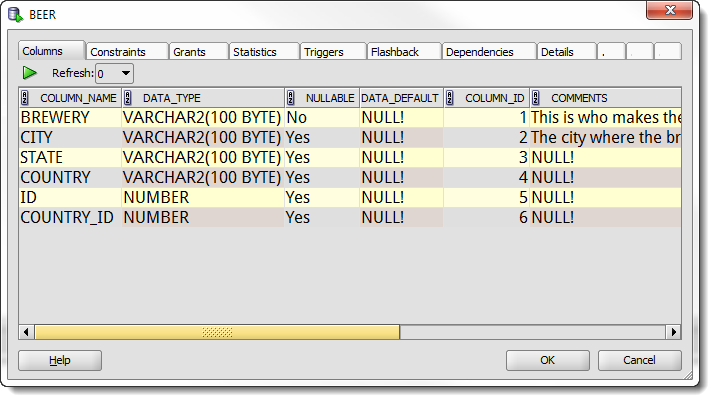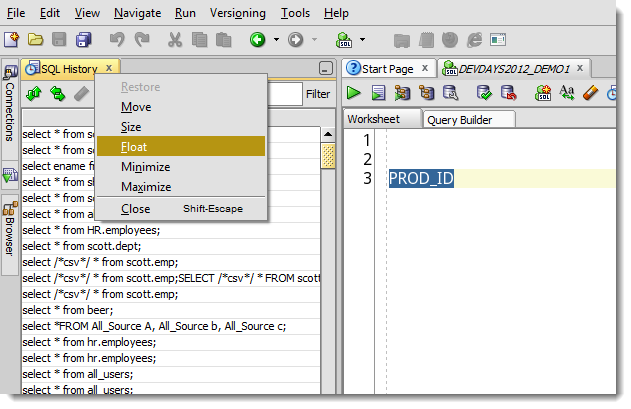Floating Panels and Describe Windows in Oracle SQL Developer
Posted
by thatjeffsmith
on Oracle Blogs
See other posts from Oracle Blogs
or by thatjeffsmith
Published on Fri, 21 Sep 2012 18:55:42 +0000
Indexed on
2012/09/21
21:49 UTC
Read the original article
Hit count: 618
One of the challenges I face as I try to share tips about our software is that I tend to assume there are features that you just ‘know about.’ Either they’re so intuitive that you MUST know about them, or it’s a feature that I’ve been using for so long I forget that others may have never even seen it before. I want to cover two of those today -
- Describe (DESC) – SHIFT+F4
- Floating Panels
SQL Developer and Describe
DESC or Describe is an Oracle SQL*Plus command. It shows what a table or view is composed of in terms of it’s column definition. Here’s an example:
SQL*Plus: Release 11.2.0.3.0 Production on Fri Sep 21 14:25:37 2012 Copyright (c) 1982, 2011, Oracle. All rights reserved. Connected to: Oracle Database 11g Enterprise Edition Release 11.2.0.3.0 - Production With the Partitioning, OLAP, Data Mining and Real Application Testing options SQL> desc beer; Name Null? Type ----------------------------------------- -------- ---------------------------- BREWERY NOT NULL VARCHAR2(100) CITY VARCHAR2(100) STATE VARCHAR2(100) COUNTRY VARCHAR2(100) ID NUMBER SQL>
You can get the same information – and a good bit more – in SQL Developer using the SQL Developer DESC command. You invoke it with SHIFT+F4. It will open a floating (non-modal!) window with the information you want. Here’s an example:
A few ‘cool’ things you should be aware of:
- I can open as many as I want, and still work in my worksheet, browser, etc.
- I can also DESC an index, user, or most any other database object
- I can of course move them off my primary desktop display
The DESC panel’s are read-only. I can’t drop a constraint from within the DESC window of a given table. But for dragging columns into my worksheet, and checking out the stats for my objects as I query them – it’s very, very handy.
Try This Right Now
Type ‘scott.emp’ (or some other table you have), place your cursor on the text, and hit SHIFT+F4. You’ll see the EMP object open. Now click into a column name in the columns page. Drag it into your worksheet. It will paste that column name into your query. This is an alternative for those that don’t like our code insight feature or dragging columns off the connection tree (new for v3.2!)
Got it?
SQL Developer’s Floating Panels
Ok, let’s talk about a similar feature. Did you know that any dockable panel from the View menu can also be ‘floated?’ One of my favorite features is the SQL History. Every query I run is recorded, and I can recall them later without having to remember what I ran and when. And I USUALLY use the keyboard shortcuts for this.
But sometimes I still want to see my recall list without having to give up my screen real estate. So I just mouse-right click on the panel tab and select ‘Float.’ Then I move it over to my secondary display – see the poorly lit picture in the beginning of this post.
And that’s it. Simple, I know. But I thought you should know about these two things!
© Oracle Blogs or respective owner


